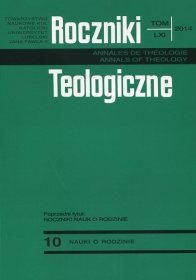Religious Freedom: The Foundation for Social
Abstract
The research presented is rooted in the academic approach to comprehend and lay into practice the theoretical key term “religious freedom”, that is a personal challenge experienced in Nigeria, For example, the continuous threat of the Islamic fundamentalist sect Boko Haram. The discussion here involves a very complicated and complex term including the neglect of the historical approach to the religious freedom, the position of the Catholic Church, its content and collective dimensions, its limits and finally the comparison between the religious and the ecclesiastic freedom. In this condensed version I would like to analyze: “What is Religious Freedom?”; “Religious Freedom as a Human Right”; “The Contribution of the Church to the Development of the Doctrine of Religious Freedom in the Church”; and finally “The Significance of Religious Freedom to Today's Society”. Once more, it's not a theoretical approach only, the discussion is about something real, happening hic et nunc, it's a visible example with the functions of law, among which imperative ones ought to be mentioned: 1. Law is to aid a society in the achievement of its goals. It is to facilitate that attainment of the purpose or common good of the society; 2. Law is to afford stability to the society, that is, to provide good order, reliable procedures, and predictable outcomes; 3. Law is to protect personal rights and provide avenues of recourse, redress of grievances, and means for the resolution of conflicts; 4.Finally, law is to assist in the education of the community by reminding everyone of its values and standards. So, what is actually the role of the religious freedom for the social peace?
References
Amaladoss M.: “Identity and Harmony: Challenges to Mission in South Asia”, in Mission in the Third Millenium, ed., Robert J. Schreiter, New York: Orbis Books, 2001, 25-39.
Aquinas T.: Summa Theologica. 3, trans. Fathers of the English Dominican Province, Maryland: Christian Classics, 1981.
Bokenkotter T.: A Concise History of the Catholic Church. London: Image Books Doubleday, 1990.
Benedict XVI: “World Day of Peace 2011”, in Origins, 40, Washington: Catholic News Service Description, 2011, 499-504.
CarrillodeAlbornoz A.F.: The Basis of Religious Liberty, London: SCM Press, 1963.
Carrera F.: “Egypt: Violence against Christians”, New People (July – August 2011), 8-9.
Carrera F.: “Nigeria: Archbishop of Jos Criticizes Government”, New People (July-August 2012), 8-9.
Casserley J.V.L.: “The Need to Affirm Religious Freedom”, in Religious Liberty: An End and a Beginning, ed., John Murray. New York: The Macmillan Company, 1966, 135-157.
“Dignitatis Humanae”, 7 Dec. 1965, in The Conciliar and Post Conciliar Documents, I-II, ed., Austin Flannery, Mumbai: St. Pauls, 1975, 703-714.
Faul D.: “Donatism”, in New Catholic Encyclopedia, vol. 4, Washington: The Catholic University of America, 1976, 1001-1003.
JohnPaul II: Codex Iuris Canonici, Constitutione Apostolica Sacrae Disciplinae leges, 25 ianuarii 1983, promulgates, in AAS 75 Pars II (1983); English Translation. The Code of Canon Law, New Revised English Translation, Bangalore: Theological Publications in India, 1997.
Holmes J. – Bickers B.W.: A Short History of the Catholic Church, Kent: Burns & Oates, 1983.
Koshy N.: Religious Freedom in a Changing World, Geneva: WCC Publications, 1992.
Copyright (c) 2014 Roczniki Teologiczne

This work is licensed under a Creative Commons Attribution-NonCommercial-NoDerivatives 4.0 International License.





